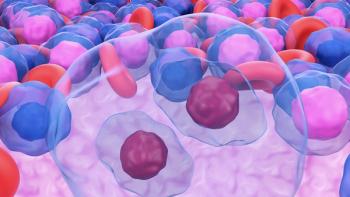
Oncology Nurses: What Cannabinoid Is Your Patient Taking?
Karen Hande, PhD(c), DNP, ANP-BC, CNE, FAANP, ANEF, explains the difference between some of the popular cannabinoid products that patients with cancer may be taking.
Cannabinoids are becoming more popular for patients with cancer as a pain management strategy. However, with inconsistent laws across states and federal bodies, it can be difficult for nurses and patients to comfortably discuss cannabinoids and cannabinoid use.1
As the public perception and patient success stories with unconventional, alternative, and natural therapeutics shift consumer attitudes, it is important for nurses and their patients to understand the differences in the products and the adverse effects associated with each. According to a study by Butler et al in 2021, nearly half of individuals who participated in a survey who had consumed cannabidiol (CBD) did not disclose use to their health care provider.
“We see a lot of patients who have been trying to talk to us about CBD [cannabidiol], and cannabinoids and THC, [tetrahydrocannabinol]” Karen Hande, PhD(c), DNP, ANP-BC, CNE, FAANP, ANEF, a professor of nursing at Vanderbilt University School of Nursing, said in a presentation during the Oncology Nursing Society Bridge.
Although Hande stated in her presentation that she was no expert in cannabinoids or medical cannabis, her clinical research primarily focuses on helping patients effectively manage their cancer-related pain. Therefore, she has become very interested in cannabis and has dedicated a lot of time and research to best understand the evidence-based data that exists for these products. In her presentation, “Cannabinoids for Patients With Cancer,” Hande discussed the available evidence on CBD and the possible risks, particularly in vulnerable populations.
“I think it’s just important for under us to understand a kind of broad overview about cannabinoids and THC and CBD, because this gives us a better understanding of where the laws come into play,” Hande said. She added, “It took me quite some time to try to understand all the differences and trying to make sure I give the correct information to my patients.”
Cannabinoids Vs Cannabis
A key concept for oncology nurses to understand, according to Hande, is the variations of cannabinoids.
Cannabinoids are compounds found in the cannabis plant. These compounds interact with the human endocannabinoid system. The exact relationship still required further understanding.
“Cannabis has many names for [many] strains, and hemp and marijuana are under this big umbrella of cannabis plants; they are all considered to be 1 species: the cannabis sativa plant,” she said. “This is a genus of flowering plants. And these can contain about over 100 phytocannabinoids, [and] they have a wide range of effects on the body in the brain.”
The following products are derived from cannabis: marijuana, hemp, THC, and CBD. In addition, there are man-made synthetic cannabinoids (K2/Spice); however, these agents are designed to mimic the mind-altering effects of illicit drugs. For her talk, Hande chose to focus on the products derived from the plant itself, as oncology nurses are more likely to encounter patients using plant-derived products.
Marijuana
If a patient reports marijuana use, this means they are using the dried flowers, leaves, stems, and seeds of the cannabis plant. Marijuana is also known as cannabis, weed, pot, or dope. Specifically, it can be defined as a plant with at least 0.3% delta-9 THC by weight. It is consumed by smoking (joints, blunts, bongs), vaping (vaporizing electronics devices), or by mixing or infusing it into foods or drinks (edibles).
“This is an important differentiating factor that I’ll be highlighting regularly through this talk,” Hande said during her presentation. “Marijuana is more than 0.3% of THC by weight.”
Marijuana is the most used federally illegal drug in the United States, with approximately 18% of Americans reported using it at least once in 2019 (~48.2 million Americans).1
Precautions With Marijuana
Because marijuana has THC, it is associated with the following health risks: alterations in memory, learning, attention, decision-making, coordination, emotion, and reaction times.2 In terms of long-term health, marijuana has been linked to an increased risk of psychosis and schizophrenia,3 and, like other drugs, it’s use during pregnancy may increase the risk of embryo-toxicities.4 Moreover, this drug, depending on where it is sourced, may be laced with other substances. Consumers may or may not be aware of other substances in their product.
Using marijuana in combination with other agents may also result in impairment and can increase the risk of overdose.
Federally, marijuana is illegal as a recreational drug. It is classified as a schedule 1 drug, per the Drug Enforcement Agency. Although it is legal in some states for medical for nonmedical adult use, this does not mean that is safe, Hande noted. Specifically, smoking marijuana can expose users to harmful chemicals, and insufficient evidence exists to document the safest method for consuming.
Hemp
Legally, hemp must contain a THC concentration of less than 0.3% by dry wright. It is the same species of plant as the cannabis plant and, along with bamboo, it is one of the fastest growing plants on Earth. There are almost no restrictions on hundreds of compounds made by the plant. Industrial hemp is cannabis sativa plant grown specifically for industrial or medicinal use.
“Many states across the country have hemp cultivation,” Hande said. “This allows cultivation of hemp from commercial or research or pilot programs. There are only a few states that do not allow cultivation of hemp.”
In 2018, the farm bill legalized the production and sale of hemp and its extracts, removing the product from the controlled substance act. Of note, per federal law, hemp cannot contain greater than 0.3% THC. If the concentration of THC surpasses this measurement, it is classified as marijuana.
As of September 2022, 47 states have enacted legislation to establish hemp production programs or cultivation research.
THC Vs CBD
THC is a compound of the cannabis plant. This psychoactive agent causes, what is known as a high. It is consumed via dabbing—a specific method for inhaling THC concentrates.
Unfortunately, the concentrated forms of THC mean that there is an increased risk of additives or contaminating substances existing in the product.
CBD is another active cannabinoid found in the cannabis plant. This agent is not psychoactive and consequently does not cause a high.
CBD can be derived either directly from the cannabis plant or from a hemp product. The key difference between cannabis- and hemp-derived CBD is the concentration of THC. Hemp-derived CBD must have a THC concentration less than 0.3% to be federally legal. CBD products containing greater concentrations are federally illegal but are legal under some states.
“The main difference between cannabis and hemp-derived CBD is the amount of THC that it can contain,” Hande stressed. “Hemp-derived CBD includes less than 0.3% of the THC. [Therefore,] it’s federally legal to use hemp-derived CBD, but CBD products that contain more than 0.3% of THC are federally illegal. This is where the conflict between the state and the federal laws [can arise].”
The extraction process for CBD and THC are similar; farmers harvest the hemp and it is sent to an extractor. If the extraction is not performed with pharmaceutical grade standards, the CBD may become contaminated with THC, chemical solvents, or even pesticides. This is compounded by the fact that the US does not hold CBD supplies to a standard, and federal enforcement is lacking.
CBD Produced Delta-8 THC Products
CBD can be converted into delta-8-THC, delta-9 THC, and other THC isomers through a solvent, acid, and heat. These products end up with higher concentrations of delta-8 THC than those which occur naturally in the cannabis plant. Consequently, these products may create harmful by-products that presently are not well-characterized.
Delta-8 THC products are increasing in popularity, in both marijuana- and hemp-based markets. It is appearing in markets that are operating legally under state, territorial, or tribal laws.
As of 2022, most states and territories permit full and restricted marketplaces where consumers can purchase hemp and hemp-derived CBD products.
According to Hande, there are a wide variety of delta-8 THC-containing products in the market. For example, vapes, smokable hemp sprayed with delta-8 THC extract, distillates, tinctures, gummies, chocolates, and even infused beverages can fit into this category. Moreover, the testing method for these products are still under development. This means that Delta-8 THC products may not be systematically tested for contaminants such as heavy metals, solvents, or pesticides which can cause adverse health effects.1
How to Talk to Your Patient About Cannabinoid Use
Nurses hold a key role in discussing not only the risks of cannabinoid use but providing educational information for the safe consumption. Should a patient be interested in trying CBD products, counsel on the lack of evidence, contaminants, misleading labels, and legal issues of surrounding use. One approach to counter the “buyer beware” notion is to provide evidence-based patient education and to screen for any drug/drug interactions that may occur should the patient consume CBD products.
Additionally, assessing the patient’s baseline knowledge base before use will be beneficial and open communication may help establish trust and increase reported use between the patient and the health care provider. Finally, addressing the topic early on in care may remove the barrier of the stigma surrounding cannabinoid use.
Hande concluded by adding that many trials are ongoing in the cannabinoid arena and that results are expected to be published over the next several years. She noted that the oncology nurses should be up-to-date on the latest findings to provide guidance.
References
- Marijuana and public health data and statistics. Centers for Disease Control and Prevention. June 8, 2021. Accessed September 14, 2022. bit.ly/3ROqaoi
- Testai FD, Gorelick PB, Aparicio HJ, et al. Use of marijuana: effect on brain health: a scientific statement from the American Heart Association. Stroke. 2022;53(4):e176-e187. doi:10.1161/STR.0000000000000396
- Di Forti M, Quattrone D, Freeman TP, et al. The contribution of cannabis use to variation in the incidence of psychotic disorder across Europe (EU-GEI): a multicentre case-control study. Lancet Psychiatry. 2019;6(5):427-436. doi:10.1016/S2215-0366(19)30048-3
- Health effects of marijuana and cannabis-derived products presented in new report. National Academies. January 12, 2017. Accessed September 14, 2022.
https://bit.ly/3DqldgN
Newsletter
Knowledge is power. Don’t miss the most recent breakthroughs in cancer care.
















































































